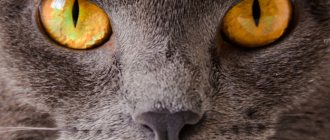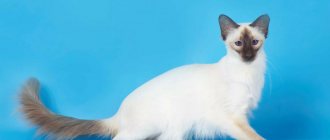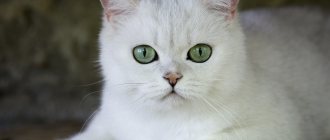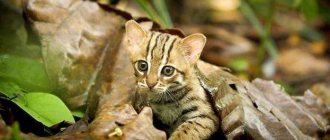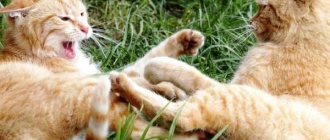How to properly care for a Thai cat
Any animals that appear in the house are not toys or furnishings at all.
These are living beings with their own character, habits and preferences. This statement is especially true for purebred cats. A Thai cat is a faithful friend for life if you raise your baby correctly from the moment he appears in the house. The kitten of this breed is distinguished by its restless disposition, curiosity and playfulness. The baby constantly requires maximum care, love and attention from the owner.
The animal’s motto can be considered the phrase: “in my house nothing can happen without my participation.” Such a pet will always be close to the owner. Sleeping, eating, water procedures, cleaning and other household chores - Thai cats prefer to do all this together with a person, never leaving him alone for a minute.
The owner of a purebred kitten must realize in advance that the inquisitive baby has taken a strong place in his life, he will sleep and walk with the owner, comment on his every action, expecting affection and conversations in return.
Do not forget that animals of this breed are considered long-lived in the cat family. How long do Thai cats live? With proper care and proper nutrition, an animal can reach the age of 25 years, and this is not the limit; there are cases when a pet’s lifespan was calculated at 27-28 years.
All about the nutrition of Thai cats
Properly organized nutrition is the key to the health and longevity of any animal. What to feed a Thai cat, and how to organize this process correctly?
The main mistake of many owners can be considered the wrong approach to feeding their pets. Cats should not get food from their owner's table! From such food, animals develop various ailments that are difficult to treat.
Kittens that are not fed properly can grow completely disproportionate. Too long legs, a damaged back line, a sagging abdomen, an overdeveloped middle part of the body - all this is the result of improper feeding of the pet. And the successful mating of mature Thai cats directly depends on a balanced diet.
If you start feeding your pet correctly from the first days of its life, then by the time of puberty the quantity and quality of germ cells will allow you to get healthy and numerous offspring. This statement is true for both males and females.
So, from the moment a Thai kitten appears in your home, you need to take a serious approach to organizing its feeding. Food must meet three basic requirements:
- completeness. It is necessary to take into account the quality composition of food for the animal;
- rationality. You need to understand your pet’s needs and carefully calculate the serving size; excess or lack of food will have a bad effect on full development;
- balance. Food for pussy should be varied, rich in all the necessary vitamins, minerals and acids.
People just starting to care for a kitten are often interested in: how often should the animal be fed? The answer can be found in the wild; you just have to remember the many ancestors of the domestic cat. What a cat is at its core is, of course, a predatory animal that prefers to hunt alone and then slowly eat the caught game.
Outside the home, a hunting cat can eat up to twenty times a day, eating prey in small portions. Therefore, at home it is recommended to feed the cat at least ten times a day. In practice, it looks like this: the animal must have clean water and fresh food almost around the clock. Prolonged fasting is very harmful to the pussy body!
Two power options: which one to choose?
There are two options for complete nutrition for Thai cats; which one to choose is up to the owner of the animal.
- Feeding with high quality dry food.
There is an opinion that ready-made food is the best nutrition option for cats. The food supposedly contains all the nutrients, vitamins and minerals necessary for the animal to live a full life. Using such food in everyday life frees up a lot of free time for the animal owner, because it is enough to put a portion of fresh food in a bowl and do not forget to pour clean water into another.
But there are also some disadvantages that you should be aware of. Numerous studies confirm that animals that eat dry food (regardless of brand and quality) are almost twice as likely to have problems with urination, cystitis or hematouria (blood in the urine), and urolithiasis.
We should not forget about the low quality of many dry foods that are widely advertised on television. When choosing this food option for a cat, you need to select high-quality dry food and test the animal’s urine at least once a year in order to identify a possible disease in time.
- Eating natural products specially prepared for cats (natural nutrition).
Natural products do not include cheese, sausage or food from the human table, but meat, vegetables, fish and dairy products specially prepared for the pet.
The animal can be given only lean varieties of meat: chicken, veal, rabbit or turkey meat, cut into small cubes, are suitable. The finished portion must be treated with boiling water or deep frozen and thawed in a microwave oven. This way you will be able to get rid of pathogenic bacteria that quickly develop on raw meat. Liver is not recommended for cats of the Thai breed; its use leads to color changes.
It’s good to diversify your pet’s menu with fish. Sea fish (except for pollock and cod, which are not advisable to include in the diet) is given to the cat raw. River fish must be cooked. Large bones should be removed and the processed fish divided into small pieces. Such food should appear in a bowl no more than once a week.
You can treat your pussy with kefir, cottage cheese and sour cream. Fermented milk products are very beneficial for cats.
Eggs are another extremely healthy dish. All pussies love raw yolks, but it is recommended to give the white only boiled.
A spoonful of vegetable oil, occasionally added to food, will have a positive effect on the animal’s digestion. Sometimes you can pamper your pet with butter. The fats contained in oils perfectly care for your pet's fur, giving it shine and silkiness.
Raw vegetables or pieces of fruit, sprouted oats or wheat, all this must be present in a kitty’s balanced diet.
Any cereals cooked in water should also be included in the diet in small quantities.
But when choosing a way to feed your pet, you should remember that you need to feed the animal with one thing - either dry food or natural dishes. These products should not be given at the same time.
Basic rules of care
Caring for a wayward Thai cat involves not only proper nutrition, but also compliance with certain hygiene standards. It is very important to teach the kitten to do his cat business in the tray, and not throughout the apartment. How to toilet train a baby if a kitten brought into the house is confused and scared?
Almost always, the baby begins to go to the tray even before he gets to the new owner. Therefore, so that he does not lose the acquired skill, you need to find out in advance what kind of litter the kitten’s previous owners used, and purchase it for the first time.
How to toilet train a small cat:
- a pet brought into the house needs to be shown a tray filled with a familiar filler (this is very important), seated in it, allowed to sniff everything and get comfortable;
- Having caught the kitten doing something inappropriate in the corner of the room, you should dip a little cloth or paper in the urine and put it in the tray, then take the baby to the toilet and put it in it;
- There is no need to scold a small cat and poke its muzzle into a puddle of urine, such punishment can have a completely opposite effect. A wayward animal will simply refuse to go near the toilet.
Live amicably with your kitten, don’t offend him unnecessarily, and the question: “how to litter box train” will disappear by itself, because cats of the Thai breed are distinguished by extremely well-developed cleanliness.
Origin story
Thai cats are close relatives of Siamese cats.
A breed similar in appearance was first described in the 14th-15th centuries, in ancient manuscripts about cats, and it was called Vichien Mae. According to legend, they lived only in the royal chambers, protecting members of the royal family not only from snakes and dangerous rodents, but also from evil spirits. They had an amazing feature: a very dense skin, which contains a minimum of nerve endings, which made them particularly insensitive to bites and wounds. Due to this, the pain threshold was lowered, and the infection did not spread as quickly as in others. Cats were forbidden to be exported outside the state, but once the king of Thailand himself gave a couple of clear-eyed purrs to the British ambassador as a sign of special favor. The kittens created such a sensation that the ruler sent several dozen cats to the British court.
Initially, the breed was called the “Royal Siamese”, but during active breeding work in the 19th century, another breed was developed, differing in body shape, facial features and color. The first standard was drawn up in 1990, and registration with the WCF organization was carried out in 1991.
At the first exhibitions in Leningrad and Moscow, Thai cats were exhibited under the name “Old Siamese”.
Thai kitten food
In most cases, the baby is weaned from the nursing mother at the age of 8–10 weeks. During this period, a new home is found for him, and the kitten finds a loving owner. Naturally, the latter has a question: what to feed a Thai kitten for 2 months?
The ideal answer to this question is to seek help from a veterinarian who will examine the kitten, make a conclusion about its state of health and give recommendations on how to plan the baby’s diet. If it is not possible to undergo a veterinary examination, then you can use general tips on creating a menu for a little Thai.
Important to remember! Before you start feeding the kitten yourself, you should definitely ask what kind of food he received before. In this case, it is very important that his new food does not differ much from the previous diet.
As for dry and wet ready-made food, in this case only one piece of advice can be given - if there is not enough money to purchase high-quality food, then you should not give your baby cheap diets that can harm his health.
Thai kittens: food and diet
We must not forget that cats are predators. Therefore, the diet of a growing predator must include natural meat - lean poultry or beef, which is boiled and chopped.
The presence of fish is also important, which will help saturate the baby’s body with the necessary amino acids and minerals. To feed a Thai kitten, you need to choose exclusively sea fish, which also needs to be boiled, boned and chopped.
On the question of milk
Important to remember! Contrary to popular belief, milk is not the main food for kittens. Moreover! The baby will need milk only at the initial stage of development. Thanks to its presence in the diet, it will be easier for him to endure separation from his mother cat and the lack of her milk.
In the future, milk should be excluded from the diet - Thai kittens will eat cottage cheese or low-fat fermented milk products with no less pleasure, which can be given no more than 2 times a week. The main thing is to accustom them to this.
But you can remember about milk if we are talking about the best way to feed a Thai cat nursing kittens. It will be useful for purring mothers and will help ensure normal lactation.
Kitten feeding regimen
It would be optimal to organize feeding a Thai kitten - 4-6 times a day. Moreover, it is very important not to overfeed the baby, who does not yet know “a sense of proportion” and may overeat. Therefore, food should be given to the kitten in small portions and often. You can add some stewed vegetables or cereals - rice or buckwheat - to meat, fish, and dairy products.
One of the most important points in caring for a Thai cat is its nutrition. If the animal is not fed correctly from birth, this will cause a change in physique, a damaged back line and a sagging belly.
In this article we will look at how to properly feed a Thai cat and what food is suitable for her.
Homemade food for Thais
In addition to ready-made food, the diet of Thai cats should also contain natural food. The product set includes:
- meat - beef, chicken, rabbit, turkey, veal;
- fermented milk products - yogurt without fruit additives, yogurt, kefir;
- cereals – rice, semolina, oatmeal;
- vegetables - zucchini, cabbage, pumpkin;
- egg (2 times a week);
- sea fish (once a week).
Important! At least 6 hours should pass between feeding prepared foods and natural food.
It's easy to prepare a dish for your cat. Cut the meat into small cubes, add mashed boiled vegetables or cereal to it and mix. You can add a little vegetable oil. There should be 3-4 times more meat than “side dish”.
Remember that purebred cats cannot be fed food from your table. Also, there should always be sprouted grass at home. It is very beneficial for digestion.
Nutritional Features
Thais are not very picky eaters, unlike their fellow Siamese. Their menu may consist of ready-made food, natural food or mixed feeding.
Let us immediately note that the best option for cats of this breed is mixed feeding. Consuming only prepared food can affect the color of the animal.
The food of Thai cats must meet 3 requirements:
- Completeness. Food must be of high quality and fresh.
- Balance. Food should be varied, rich in minerals, vitamins and acids.
- Rationality. It is necessary to understand the needs of the animal and correctly calculate the serving size, because a deficiency or excess will have a bad effect on the cat’s health.
Important! A Thai should have clean water in his bowl around the clock. Here you need to take into account that plastic bowls are not suitable. They can accumulate dirt and eventually become a breeding ground for diseases. The cat should be fed 3-4 times a day in small portions. If you work and are away from home for a long time, leave food in a bowl. Prolonged fasting has a negative impact on your pet's health.
This is interesting: When mating season begins for cats - read all the nuances
Interesting Facts
During the history of the existence of the Siamese breed, many interesting things have been associated with cats:
- There were many famous people among the lovers of these animals. Siamese have lived with Gary Oldman, John Lennon, Harold Wilson, Vivien Leigh, Anthony Burgess, Syd Barrett and Jimmy Carter.
- In 2003, a representative of the breed named Katie claimed the right to be called the fattest cat in the world. Her body weight was 23 kg.
- In the middle of the 20th century, at the Dutch embassy in Moscow, 2 Siamese dogs sensed something was wrong and began to scratch the walls, hiss and arch their backs. The employees of the institution quickly responded to this behavior of the animals and examined the premises - they found numerous hidden listening devices in it.
- There are several varieties of Siamese cats. They all look alike and belong to the Eastern Oriental group. The closest relative of the Siamese is the Thai cat. They have many similarities and are often confused with each other. And long-haired cats that appeared as a result of a natural mutation are called Balinese and have the status of a separate breed.
Calculation of daily portions
Some people naively believe that cats will independently determine the portion of food they need. This is wrong. Among animals there are gluttons who are ready to swallow much more than their body requires. Having poured the entire day's portion into such a cat's bowl in the morning, in the evening you can see an empty dish and the sly meowing pitifully.
You can’t rely on your pet’s appetite either. You need to calculate your food needs yourself. This indicator depends on the age and weight of the cat. For example, for pets aged 1.5 to 9 months, the calculation is carried out using the following formula: animal weight (g) x 0.1 = daily serving rate (g).
That is, the required weight of food for babies is 10% of their own weight. If a kitten weighs 1.5 kg, he will need 150 g of natural food per day. In this case, the portion is divided into several feedings. Kittens at 3 months are fed 5-6 times, babies older than 6 months are transferred to 3 feedings a day.
Calculation of portions for an adult animal is carried out using a different formula: animal weight (g) x 0.05 = daily food intake (g). That is, for adult cats, the serving weight is only 5% of body weight. For example, a cat weighing 5 kg needs 250 g of food. This portion is divided into 2 times.
Most of the diet (70-80%) should consist of meat and offal. The rest of the menu is formed from fermented milk products, vegetables, and herbs.
If ready-made feed is used, the required amount is indicated on the package. You should not give more or less than the prescribed portion. Malnutrition, like overeating, has a negative impact on health.
Breed description, standards, appearance
Siamese cats are small animals with small bones and a flexible, muscular body. They are distinguished by their proportional build and thin limbs. In 1892, the first standard was adopted, which provided a detailed description of the breed.
Over time, the Siamese cat changed its appearance greatly, and in 1902, appropriate adjustments were made to the document.
Dimensions and weight
Siamese are graceful animals of medium size. The breed has developed sexual dimorphism, which is why cats are lighter and smaller than males. An adult Siamese weighs on average 4-6 kg. The weight of the female varies between 3-4 kg.
Anatomical characteristics
According to the generally accepted standard, a real Siamese cat should look like this:
- The head is wedge-shaped, with a narrow muzzle, a straight nose and an absent stop.
- The ears are large, wide at the base, set low, with pointed tips.
- The eyes are almond-shaped, slanted. The iris is colored bright blue.
- The body is stretched, flexible, with developed muscles and small bones.
- The limbs are thin and long. The front legs are shorter than the hind legs. The paws are small, oval.
- The tail is thin, long, tapering from base to tip.
Color and coat type
Siamese are short-haired animals with a pleasant-to-touch coat. Their glossy, shiny hairs fit tightly together.
Representatives of the breed have recognizable colors. Depending on the shade of the main background and markings, the following color varieties of Siamese cats are distinguished:
- Blue point. The main background is painted white with a slight blue tint. The markings on the body of Blue Point Siamese are dark blue. The nose and paw pads are gray.
- Seal point. In this case, the Siamese’s light body has dark brown, almost black markings.
- Chocolate point. The ivory coat has markings with a hint of milk chocolate.
- Lilac Point. This coloration is a combination of a lavender background and soft gray markings with a pink tint.
- Red point. This color combines a white or apricot background and orange-red or tan markings.
- Cream point. In this case, cream spots are distributed on the almost white coat of the Siamese.
Siamese of fawn, cinnamon, tortoiseshell and caramel colors are much less common. Although some felinological associations recognize only chocolate, blue point, seal point and lilac point colors, these cats have about 50 color variations in total.
Dark markings may have a striped pattern.
On a note. A Siamese cat is only white at birth. After a few days, marks appear on her body, which darken over time. The final color of the Siamese is formed by 10-12 months.
Possible breed defects
Flaws in appearance, in the presence of which Siamese cats will not receive high marks for exterior:
- creases on the tail;
- white spots on the body;
- pale or non-blue iris;
- malocclusion.
How to feed a Thai kitten
Typically, a kitten is separated from its nursing mother at the age of 2 months. From this moment you can start the first complementary feeding. Only high-quality feed is suitable for this. Cheap diets can negatively affect the health and physique of the baby.
The following foods are suitable for feeding Thai kittens:
- Cimiao Kitten;
- Innova Cat and Kitten;
- Chicken Soup for the Soul;
- ProNature Chicken and Sweet Potatoes;
- Royal Canin Babycat Milk (milk formula), Babycat Instinctive.
Dry food should be pre-soaked in water. Otherwise, scratches may remain in the kitten's stomach. Don't worry if your baby initially refuses the food offered. Offer him food periodically, someday curiosity will take over, and he will definitely try. Additional subtleties of the diet are here.
Important! A Thai kitten should be fed 4-6 times a day. At the same time, do not overfeed your small pet, because he may overeat. That is why food should be given often and in small portions.
This is interesting: Nibelung cat photo: let’s look at it in order
Nutrition for illnesses
The Thai cat breed has no predisposition to genetic diseases. Good immunity and good health allow these pets to live 15-20 years, and sometimes longer. However, an incorrect diet, living in unfavorable regions, and lack of access to water can lead to the development of urolithiasis (KD).
If the cat eats ready-made food, it is advisable to switch it to natural food. If this is not possible, it is necessary to change the brand of food. Manufacturers that produce high-quality food offer special mixtures for pets with KSD, for example, Royal Canin Instinctive in the form of jelly.
Tartar and other dental problems occur when a cat eats soft foods. Royal Canin ORAL Sensitive 30 food in the form of dry granules is designed specifically for pets prone to dental diseases.
When choosing food for your pet, you need to remember the saying that “the miser pays twice.” Saving on food for a kitten results in huge health problems. Trips to the veterinarian, examinations, and medications are much more expensive than the most elite food.
Siamese cat: character traits and behavior
Once in a family, a Siamese cat or she-cat immediately chooses one owner. They single him out from all family members and are devoted to this choice all their lives.
They have an independent character, highly developed intuition, and love to explore and play. Smart, active, willful, demanding of communication. They do not tolerate unceremonious treatment. They do not forgive insults, they know how to stand up for themselves.
They quickly get used to a new environment. They express their needs and feelings in a voice whose intonations have many variations. If a cat is very scared or dissatisfied with something, it can express protest with a long and loud howl.
Very often they are jealous and do not want to share their owner’s love with other family members and animals. They are wary of outsiders. They tolerate sharp sounds and excessive noise very poorly. A dysfunctional atmosphere in the family can lead to illness in a Siamese cat.


